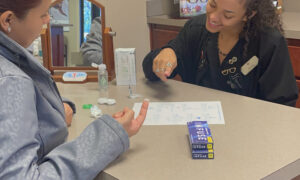 One-month replacement contact lenses are popular, but patients don’t like following your wear and care recommendations nearly as much. The most popular modality purchased are monthly replacement (45.1 percent), according to Jobson Optical Research’s 2013 Contact Lens Insight Survey. Discarding and replacing contact lenses every month was recommended by 37.5 percent of respondents’ eye doctors, however only 32.3 percent of respondents said they usually change their contact lenses every month.
One-month replacement contact lenses are popular, but patients don’t like following your wear and care recommendations nearly as much. The most popular modality purchased are monthly replacement (45.1 percent), according to Jobson Optical Research’s 2013 Contact Lens Insight Survey. Discarding and replacing contact lenses every month was recommended by 37.5 percent of respondents’ eye doctors, however only 32.3 percent of respondents said they usually change their contact lenses every month.
Click HERE to purchase Jobson Optical Research’s 2013 Contact Lens Insight Survey.
Compliance is always an issue in all modalities of patient care. Combine that with the fact that we live in a litigious society and we have a potentially explosive formula. We’ve known good optometrists who’ve been involved in malpractice lawsuits. The stress of a malpractice lawsuit is always present no matter the state of innocence. No doctor wants to be involved in a malpractice lawsuit.
Since malpractice lawsuits do occur, it is important to have some background knowledge. Here are seven things to know and do right now and 10 things to do if you are served with a malpractice lawsuit.
7 Things To Know And Do Right Now
1) Patients are less likely to sue a doctor they like. Make sure your patients like you.
2) Download and review the AOA Clinical Practice Guidelines–they can be found at this link: http://www.aoa.org/optometrists/tools-and-resources/clinical-care-publications/clinical-practice-guidelines
3) Review your in-office treatment protocols (standard of care) and compare them to published guidelines.
4) Document everything. Keep great records, not just good records (e.g.: How well do you document patient compliance, as well as your patient instructions? How well do you document your “on-call/after hours” care of patients that you just handle over the phone?).
5) Keep your malpractice insurance coverage current and at appropriate levels.
6) Know the difference between consultations and referrals and when to do each.
7) Co-management means sharing documentation with each doctor on each visit.
10 Things To Do If You Are Served With A Malpractice Lawsuit.
1) It is imperative that you do not make any changes to the patient record.
2) Contact your attorney immediately to know what you can and cannot say or do.
3) Contact your insurance carrier immediately.
4) Notify your state board.
5) The defense attorney (usually provided by the malpractice insurance carrier) will meet with you to understand the case and create a defense strategy.
6) Understand the timeline. It will always be longer than what you want it to be.
7) Stay actively involved in all phases of the lawsuit to make sure everything is accurate.
8) Do not put anything related to the claim itself in the patient’s medical chart.
9) In order to maintain your attorney-client privilege, create a separate file for all documents relating to the lawsuit.
10) Understand the three major questions to be answered in a malpractice lawsuit.
a. Was there a breach of the standard of care?
b. Is there a link between the breach of the standard of care and the damage to the patient?
c. What is the liability for the breach? Read that as how much money needs to change hands.
Most malpractice lawsuits are settled before going to trial. The decision to settle is an insurance company calculation of which path leads to the least expenditure of money. If you disagree with the insurance company decision to settle, then you need your own attorney (which comes out of your own pocket) to take the case to trial. Your decision to go down that path should also include a calculation of costs. You also need your own attorney if there is a chance the liability exceeds your malpractice coverage.
The best course of action is to prevent a malpractice lawsuit in the first place. So, your action plan for this week is to go to the top of this article, re-read 7 Things To Know And Do Right Now and make sure you have systems in place to handle each of the seven items. You definitely do not need the stress of a malpractice lawsuit. Prevention is always the best course of action.
Additional Resource
Click HERE for tips from The Health Care Group on What to Do When a Malpractice Lawsuit is Filed



























